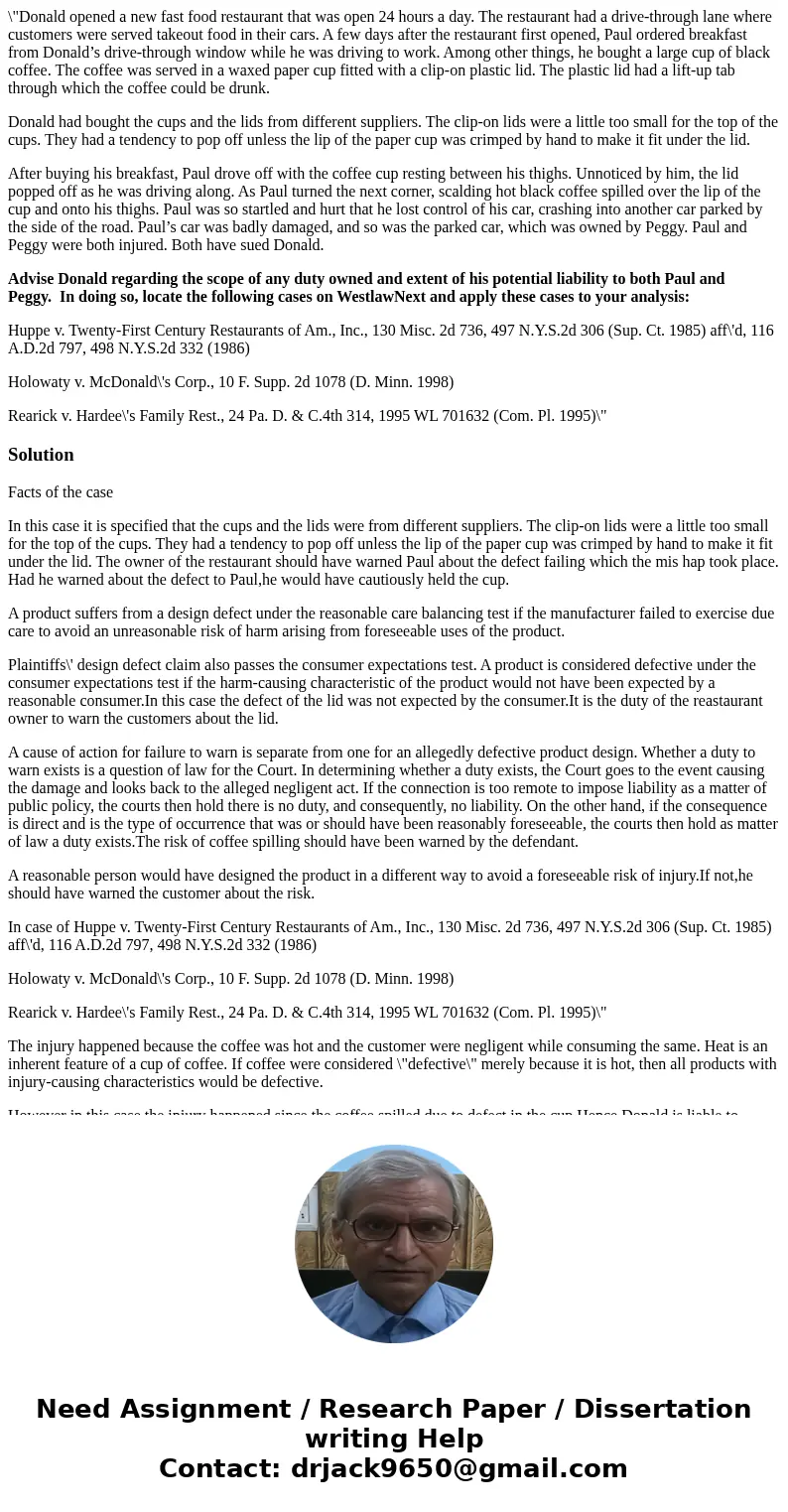Donald opened a new fast food restaurant that was open 24 ho
\"Donald opened a new fast food restaurant that was open 24 hours a day. The restaurant had a drive-through lane where customers were served takeout food in their cars. A few days after the restaurant first opened, Paul ordered breakfast from Donald’s drive-through window while he was driving to work. Among other things, he bought a large cup of black coffee. The coffee was served in a waxed paper cup fitted with a clip-on plastic lid. The plastic lid had a lift-up tab through which the coffee could be drunk.
Donald had bought the cups and the lids from different suppliers. The clip-on lids were a little too small for the top of the cups. They had a tendency to pop off unless the lip of the paper cup was crimped by hand to make it fit under the lid.
After buying his breakfast, Paul drove off with the coffee cup resting between his thighs. Unnoticed by him, the lid popped off as he was driving along. As Paul turned the next corner, scalding hot black coffee spilled over the lip of the cup and onto his thighs. Paul was so startled and hurt that he lost control of his car, crashing into another car parked by the side of the road. Paul’s car was badly damaged, and so was the parked car, which was owned by Peggy. Paul and Peggy were both injured. Both have sued Donald.
Advise Donald regarding the scope of any duty owned and extent of his potential liability to both Paul and Peggy. In doing so, locate the following cases on WestlawNext and apply these cases to your analysis:
Huppe v. Twenty-First Century Restaurants of Am., Inc., 130 Misc. 2d 736, 497 N.Y.S.2d 306 (Sup. Ct. 1985) aff\'d, 116 A.D.2d 797, 498 N.Y.S.2d 332 (1986)
Holowaty v. McDonald\'s Corp., 10 F. Supp. 2d 1078 (D. Minn. 1998)
Rearick v. Hardee\'s Family Rest., 24 Pa. D. & C.4th 314, 1995 WL 701632 (Com. Pl. 1995)\"
Solution
Facts of the case
In this case it is specified that the cups and the lids were from different suppliers. The clip-on lids were a little too small for the top of the cups. They had a tendency to pop off unless the lip of the paper cup was crimped by hand to make it fit under the lid. The owner of the restaurant should have warned Paul about the defect failing which the mis hap took place. Had he warned about the defect to Paul,he would have cautiously held the cup.
A product suffers from a design defect under the reasonable care balancing test if the manufacturer failed to exercise due care to avoid an unreasonable risk of harm arising from foreseeable uses of the product.
Plaintiffs\' design defect claim also passes the consumer expectations test. A product is considered defective under the consumer expectations test if the harm-causing characteristic of the product would not have been expected by a reasonable consumer.In this case the defect of the lid was not expected by the consumer.It is the duty of the reastaurant owner to warn the customers about the lid.
A cause of action for failure to warn is separate from one for an allegedly defective product design. Whether a duty to warn exists is a question of law for the Court. In determining whether a duty exists, the Court goes to the event causing the damage and looks back to the alleged negligent act. If the connection is too remote to impose liability as a matter of public policy, the courts then hold there is no duty, and consequently, no liability. On the other hand, if the consequence is direct and is the type of occurrence that was or should have been reasonably foreseeable, the courts then hold as matter of law a duty exists.The risk of coffee spilling should have been warned by the defendant.
A reasonable person would have designed the product in a different way to avoid a foreseeable risk of injury.If not,he should have warned the customer about the risk.
In case of Huppe v. Twenty-First Century Restaurants of Am., Inc., 130 Misc. 2d 736, 497 N.Y.S.2d 306 (Sup. Ct. 1985) aff\'d, 116 A.D.2d 797, 498 N.Y.S.2d 332 (1986)
Holowaty v. McDonald\'s Corp., 10 F. Supp. 2d 1078 (D. Minn. 1998)
Rearick v. Hardee\'s Family Rest., 24 Pa. D. & C.4th 314, 1995 WL 701632 (Com. Pl. 1995)\"
The injury happened because the coffee was hot and the customer were negligent while consuming the same. Heat is an inherent feature of a cup of coffee. If coffee were considered \"defective\" merely because it is hot, then all products with injury-causing characteristics would be defective.
However in this case the injury happened since the coffee spilled due to defect in the cup.Hence Donald is liable to compensate for the losses occurred to him and Peggy.


 Homework Sourse
Homework Sourse